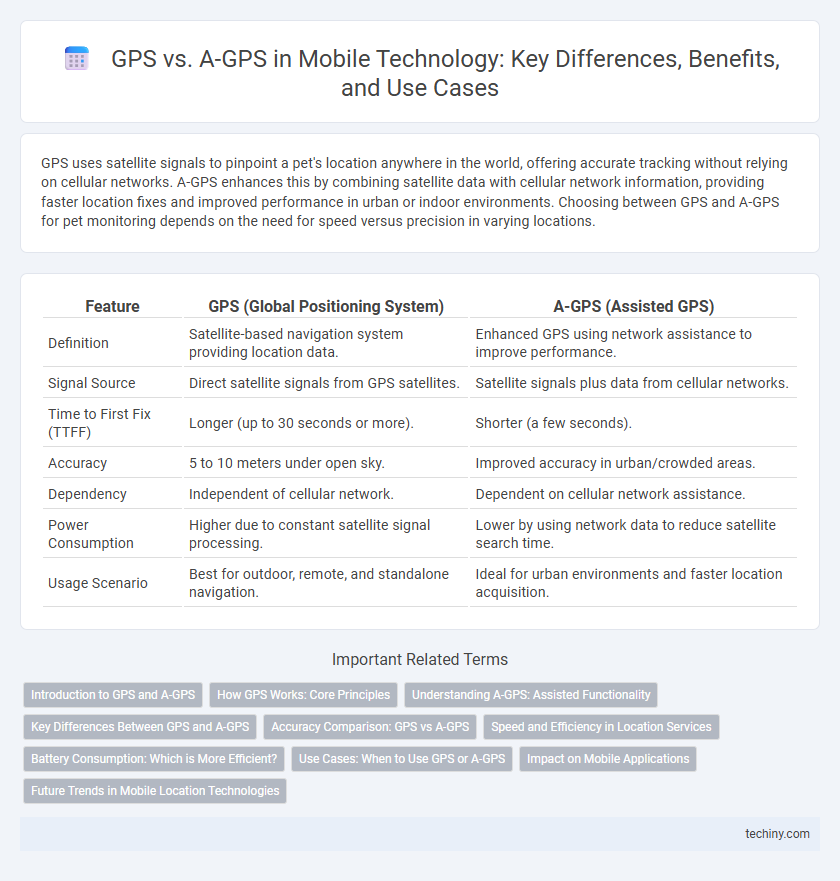GPS uses satellite signals to pinpoint a pet's location anywhere in the world, offering accurate tracking without relying on cellular networks. A-GPS enhances this by combining satellite data with cellular network information, providing faster location fixes and improved performance in urban or indoor environments. Choosing between GPS and A-GPS for pet monitoring depends on the need for speed versus precision in varying locations.
Table of Comparison
| Feature | GPS (Global Positioning System) | A-GPS (Assisted GPS) |
|---|---|---|
| Definition | Satellite-based navigation system providing location data. | Enhanced GPS using network assistance to improve performance. |
| Signal Source | Direct satellite signals from GPS satellites. | Satellite signals plus data from cellular networks. |
| Time to First Fix (TTFF) | Longer (up to 30 seconds or more). | Shorter (a few seconds). |
| Accuracy | 5 to 10 meters under open sky. | Improved accuracy in urban/crowded areas. |
| Dependency | Independent of cellular network. | Dependent on cellular network assistance. |
| Power Consumption | Higher due to constant satellite signal processing. | Lower by using network data to reduce satellite search time. |
| Usage Scenario | Best for outdoor, remote, and standalone navigation. | Ideal for urban environments and faster location acquisition. |
Introduction to GPS and A-GPS
Global Positioning System (GPS) is a satellite-based navigation technology that provides real-time location and time information globally, relying on signals from at least four satellites to determine precise coordinates. Assisted GPS (A-GPS) enhances traditional GPS by utilizing cellular network resources to improve location accuracy and reduce the time required to obtain a position fix, especially in urban environments or areas with weak satellite signals. The integration of A-GPS with mobile devices significantly boosts performance in navigation, emergency services, and location-based applications by combining satellite data with network assistance.
How GPS Works: Core Principles
GPS operates by utilizing a constellation of at least 24 satellites orbiting the Earth, each continuously transmitting signals containing their location and precise time. A GPS receiver calculates its exact position by triangulating signals from multiple satellites and measuring the time delay between signal transmission and reception. This core principle of trilateration allows devices to determine latitude, longitude, and altitude with high accuracy regardless of local infrastructure.
Understanding A-GPS: Assisted Functionality
A-GPS enhances traditional GPS by using network resources such as cell towers and Wi-Fi signals to quickly determine a device's approximate location, improving speed and accuracy especially in urban environments or indoors. Unlike standalone GPS, A-GPS reduces the time to first fix (TTFF) by accessing assistance data from servers to expedite satellite signal acquisition. This combination of satellite and network-based positioning makes A-GPS essential for mobile devices requiring rapid and reliable location services.
Key Differences Between GPS and A-GPS
GPS relies on satellite signals to determine the device's location independently, offering global coverage but slower initial positioning times. A-GPS enhances this by using cellular network data to assist in faster and more accurate location fixes, particularly in urban or indoor environments where satellite signals are weak. The key difference lies in A-GPS's hybrid approach, combining satellite and network information to improve performance and reduce time to first fix (TTFF).
Accuracy Comparison: GPS vs A-GPS
GPS provides accurate location data using satellite signals but often suffers from slower position fixes in obstructed environments. A-GPS enhances accuracy by supplementing satellite data with information from cellular networks, resulting in faster and more reliable positioning, especially in urban areas. The integration of network assistance allows A-GPS to maintain higher accuracy and quicker location fixes compared to standalone GPS technology.
Speed and Efficiency in Location Services
GPS relies solely on satellite signals to determine location, which can result in slower positioning and reduced accuracy in urban or indoor environments. A-GPS enhances speed and efficiency by using cellular network data to aid satellite signal acquisition, significantly reducing the time to first fix (TTFF). This hybrid approach improves real-time location tracking, making A-GPS the preferred choice for mobile devices requiring quick and reliable positioning services.
Battery Consumption: Which is More Efficient?
GPS relies solely on satellite signals to determine location, resulting in higher battery consumption due to continuous satellite connection efforts. A-GPS enhances efficiency by using cellular network data to quickly acquire satellite information, significantly reducing the time and energy needed for location fixes. This hybrid approach makes A-GPS more battery-efficient compared to traditional GPS in mobile devices.
Use Cases: When to Use GPS or A-GPS
GPS provides precise location tracking in open outdoor environments, making it ideal for activities like hiking, driving, and outdoor navigation where satellite signals are strong. A-GPS enhances positioning speed and accuracy in urban areas or indoors by utilizing cellular network data, benefiting use cases such as emergency services, mobile app location services, and indoor navigation. For applications requiring quick location fixes in signal-obstructed environments, A-GPS is preferred, whereas GPS suits scenarios demanding high accuracy in unobstructed settings.
Impact on Mobile Applications
A-GPS enhances mobile applications by significantly improving location accuracy and reducing the time to first fix compared to traditional GPS, especially in urban environments with obstructed satellite signals. This hybrid system leverages cellular network data to supplement satellite information, enabling faster and more reliable positioning services in mobile apps such as navigation, ride-sharing, and location-based gaming. The integration of A-GPS boosts user experience by enabling precise real-time tracking and seamless functionality in devices where quick location updates are critical.
Future Trends in Mobile Location Technologies
Emerging mobile location technologies prioritize hybrid systems that combine GPS and A-GPS to enhance accuracy and reduce latency in urban environments. Advances in satellite constellations and real-time data integration enable seamless positioning, vital for autonomous vehicles and augmented reality applications. Machine learning algorithms are increasingly utilized to predict and correct signal disruptions, driving future innovations in mobile navigation technology.
GPS vs A-GPS Infographic

 techiny.com
techiny.com